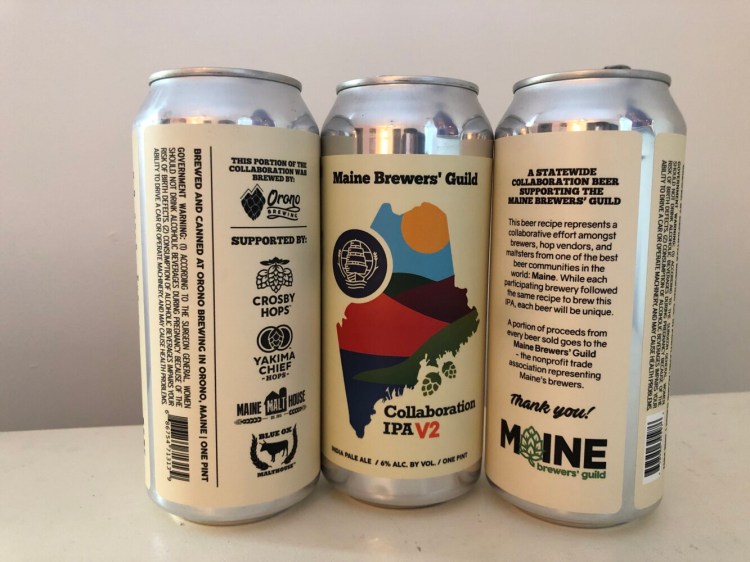Maine’s craft breweries have persevered through the pandemic with a good deal of invention and adaptation. These have also been trying times for the Maine Brewers’ Guild, the nonprofit organization that promotes the interests of breweries, when its work is arguably as crucial as ever. Two of the guild’s major fundraising tools, the Winter and Summer Session beer festivals, have been canceled in consecutive years (and there are no plans for a summer event this year).
Into that void has stepped the MBG Collaboration IPA, a beer brewed by over 50 of the guild’s members. A portion of the proceeds from each sale goes back to the guild, supporting its work. The guild’s executive director, Sean Sullivan, anticipates raising about $30,000 from the collaboration beer. He says that though this is less than they might raise from a beer festival, it remains a “substantial amount of money for our organization.” He also points to the more indirect impact of the project, aligned with the guild’s mission to promote the industry, as it “connects brewers and craft beer fans around the state.”

Goodfire Brewing’s riff featured that brewery’s signature dankness, the hops hot and punchy.
To call the MBG Collaboration IPA a single beer, though, isn’t entirely accurate. Participating breweries are working off of a shared recipe, while also putting their own spins on that formula and releasing them at different times – from December to June. And so, in truth, we have half a hundred variations on a theme, with brewers pitching in with their own harmonies, making each offering its own.
The project was originally conceived in 2020, when Crosby Hops approached the guild with an offer of support through the donation of hops. Crosby is based out of Oregon, though it has a number of Maine reps and runs some hop yards here. Yakima Chief Hops (out of Washington state) and two Maine-based maltsters – Blue Ox Malthouse in Lisbon Falls and Maine Malt House in Mapleton – also got involved, donating ingredients. New Hampshire’s Amherst Label assisted with can labels as well. A group of Maine brewers developed a recipe to accommodate the donated ingredients – Simcoe, Amarillo, Azacca, Ekuanot and Idaho 7 hops, as well as Vienna malt from Blue Ox and wheat malt from the Maine Malt House.
All five companies have been involved in the project’s second iteration, though some of the ingredients have changed. The hops for the current collaboration (dubbed “V2”) are Belma, Cryo Idaho 7 and Cryo Loral. (“Cryo” refers to the process through which the concentrated lupulin in the hop, home to the plant’s resins and aromatic oils, is extracted and pelletized, generating maximal hop intensity, while reducing some of the grassy or vegetal characteristics that might come from whole-leaf hops or standard hop pellets). Specialty malts were also made available from the donating maltsters. But brewers selected their own base malts and yeast strains, resulting in as many interpretations of the recipe as there are participating breweries – a beery version of exquisite corpse.
Tasting the adaptations from some of Maine’s major practitioners of the hazy IPA illustrates the variety of flavors and aromas that can issue forth from a single wellspring. Naturally, the hops were the star of the show in each variation, with orange and grapefruit featuring most prominently. But there were interesting distinctions to be found as well, due not only to the variations on the recipe, but also the age of the beer and thus mellowing of the hops.
The Mast Landing version (canned on Dec. 27) possessed some floral tea-like notes and a hint of bubblegum. Definitive Brewing’s offering (canned on Jan. 14) was marked by traces of lime and a bitter, citrus-pith finish. Orono Brewing’s take (Feb. 1) was relatively restrained, both balanced and approachable. And Goodfire Brewing’s (Feb. 2) riff featured that brewery’s signature dankness, the hops hot and punchy, befitting a newborn beer.

Rising Tide brewed a black IPA with roasty coffee and citrus notes.
Some breweries are veering further afield. Foundation Brewing used a lager yeast. Allagash brewed a saison with Lithuanian farmhouse yeast, featuring fruity esters alongside the cryo hop intensity. And Rising Tide has brewed a black IPA. Roasty coffee and citrus hits the nose hard, acceding to the fruitiness of the hops, before a bitter, dark chocolatey finish accented with orange.
If the beers themselves are variations of a theme, so too are the labels. In the 2020 version of the beer, breweries used essentially the same label, with small carveouts for the brewery logo and name. It was, according to Sullivan, a “visual demonstration of their commitment to each other.” But for this year’s version, brewers wanted a little more space for experimentation – both in the beer and on the label.
In the end, Sullivan says, “It’s turned into the perfect representation of our industry, with each Maine brewery contributing their own creativity to a unified Maine craft beer brand.”
Ben Lisle is an assistant professor of American Studies at Colby College. He lives among the breweries in Portland’s East Bayside, where he writes about cultural history, urban geography, and craft beer culture. Reach him on Twitter at @bdlisle.
Send questions/comments to the editors.



Success. Please wait for the page to reload. If the page does not reload within 5 seconds, please refresh the page.
Enter your email and password to access comments.
Hi, to comment on stories you must . This profile is in addition to your subscription and website login.
Already have a commenting profile? .
Invalid username/password.
Please check your email to confirm and complete your registration.
Only subscribers are eligible to post comments. Please subscribe or login first for digital access. Here’s why.
Use the form below to reset your password. When you've submitted your account email, we will send an email with a reset code.